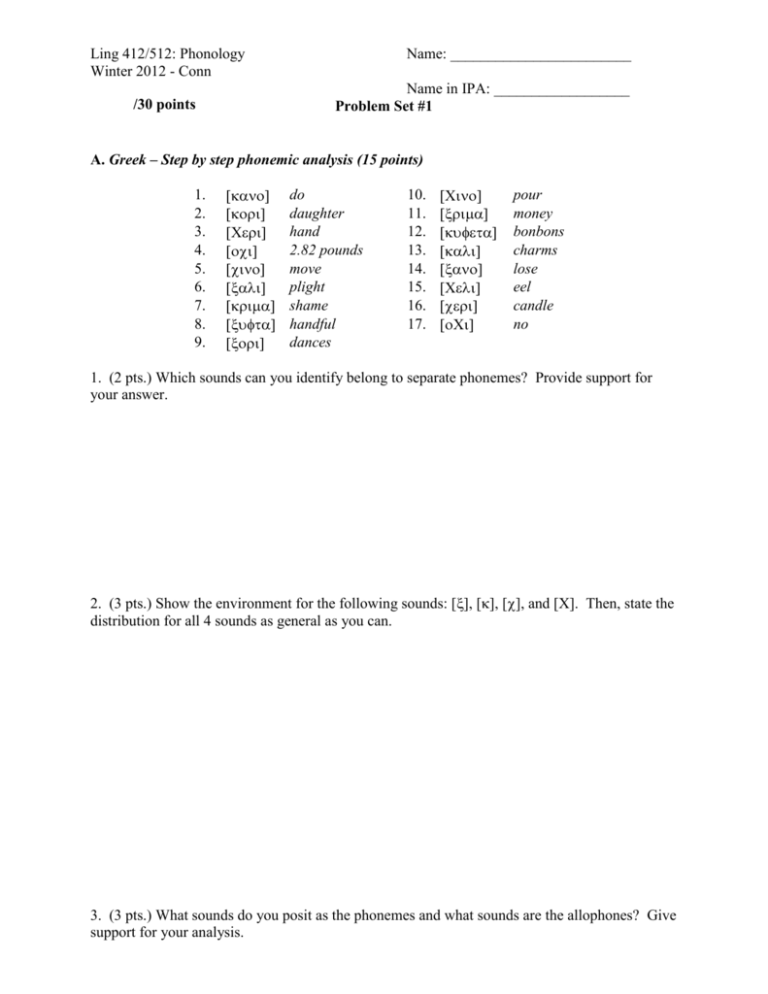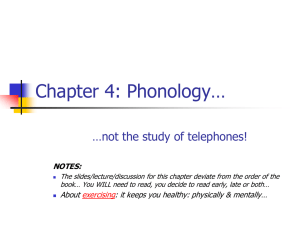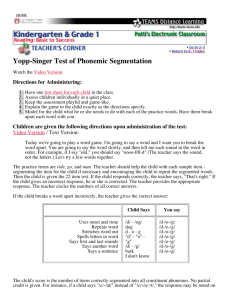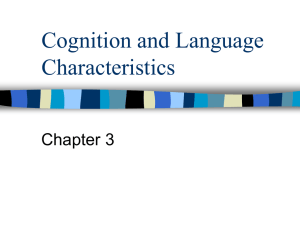Ling 390: Introduction to Linguistics
advertisement

Ling 412/512: Phonology Winter 2012 - Conn Name: ________________________ Name in IPA: __________________ Problem Set #1 /30 points A. Greek – Step by step phonemic analysis (15 points) 1. 2. 3. 4. 5. 6. 7. 8. 9. do daughter hand 2.82 pounds move plight shame handful dances 10. 11. 12. 13. 14. 15. 16. 17. pour money bonbons charms lose eel candle no 1. (2 pts.) Which sounds can you identify belong to separate phonemes? Provide support for your answer. 2. (3 pts.) Show the environment for the following sounds: [], [], [], and []. Then, state the distribution for all 4 sounds as general as you can. 3. (3 pts.) What sounds do you posit as the phonemes and what sounds are the allophones? Give support for your analysis. LING 412/512 Problem Set 1 4. (2 pts.) Provide a general rule that derives the allophones from the phonemes. If you can, provide a rule for both cases rather than two separate rules. Based on the process involved, what would you call this rule? (What is the name of the process involved here (metathesis, dissimilation, etc.)?) 5. (2 pts.) Write the phonemic form (underlying form or UR) for the following: PR UR (Phonetic Form) (Phonemic Form) move handful no charms 6. (3 pts.) Why is the alternative analysis unlikely for these data? That is, if you posit that the other form is the UR, why does this analysis look less elegant than your first choice? The best LING 412/512 Problem Set 1 way to answer this is to provide a complete analysis of the alternative hypothesis and show how it goes wrong or becomes more cumbersome than the first analysis. B. German – Not step-by-step = you show all the steps yourself (15 points) Examine the sounds [] and [] in the following data. [] represents a voiceless velar fricative, [] a voiceless palatal fricative and [] means the vowel is long. 1. 2. eight book 3. hole 4. 5. 6. high flight yo laugh 7. 8. I real (he/she/it) would 9. speak 10. to smile 11. to smell 12. to fence Provide a phonemic analysis of the 2 fricatives discussed above. Be sure to follow the same steps as the previous problem (Minimal pairs?, state distributions, select phoneme and state why, show how an alternative analysis is or is not better, etc.). These data are slightly problematic and in your analyses, be sure to discuss why it is difficult to select one analysis over the other, but do select one analysis and offer a reason why. Be sure to include 4 forms to show underlying and surface representations (2 forms per sound).











